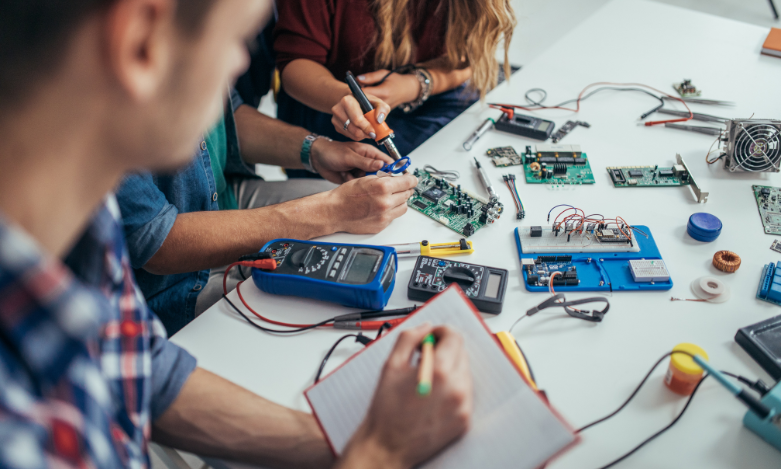CompactRIO Delivers Impact in PCB Assembly Inspection
- Apr 24, 2023
- 4 min read
Updated: Mar 27, 2024
*As Featured on NI.com
Original Authors: Alan Smith, Amfax Limited
Edited by Cyth Systems

The Challenge
Designing and developing a revolutionary XYZ measurement-based inspection technology to help companies improve the quality of their manufactured PCB assemblies.
The Solution
Combining the benefits of CompactRIO and FPGA and the user interface qualities of LabVIEW software to develop the world’s most accurate PCB assembly inspection system, enabling OEMs and CEMs to reduce their life-cycle PCB assembly inspection costs.
In the PCB manufacturing industry, an accurate and repeatable inspection of PCB assemblies has been a challenge many companies have attempted to overcome. By creating automated test equipment centered around NI CompactRIO hardware we were able to ensure many board aspects such as component placement, solder joints, etc., critical to board reliability and function.
AOI systems work by comparing recently acquired images against gold reference images. Any difference between the images results in the system reporting a failure. Many of these failures are not legitimate failures but are flagged by the AOI as potential failures. The local system operator then makes the final decision as to whether the board has failed or not. These potential failures are known as false calls.
Left: Main a3Di System User Interface Developed Using LabVIEW, Right: CompactRIO at the Heart of the a3Di Control System.
AOI systems work by comparing recently acquired images against gold reference images. Any difference between the images results in the system reporting a failure. Many of these failures are not legitimate failures but are flagged by the AOI as potential failures. The local system operator then makes the final decision as to whether the board has failed or not. These potential failures are known as false calls.
The rate of false calls on 2D and 3D AOI systems means that an operator must always be present when the PCB assemblies are inspected. This incurs additional operating costs, and the operator must halt the machine every time a potential fault is identified so that he/she can visually inspect the PCB assembly before deciding of it is a true failure or not.
What Makes a3Di Unique?
The Amfax a3Di system takes a completely different approach to address these challenges. It uses a twin laser-based metrology technology to take millions of XYZ measurements with accuracies of under 3 microns. The system scans the whole of the PCB assembly being inspected in a few seconds. We can then test these measurements against the original CAD data to identify any problems with solder joints, component location and orientation, foreign objects, or board warpage. As a3Di performs real measurement testing, we do not need an operator as there are zero false calls—either the board passes the test or not. That is the benefit of testing against real 3D measurements instead of relying on a comparative methodology such as AOI.
This means that a3Di users save the cost of at least one operator and significantly improve their product throughput as they can continuously test without pausing the machine. One consumer electronics manufacturer in Asia is testing over 18,000 boards per day on one a3Di, a significant improvement on their previous solution.
CompactRIO: The Heart of the Machine
The a3Di control system manages all aspects of the machine’s operation. We chose a CompactRIO control system for a3Di that includes FPGA and NI-9375 digital I/O hardware. This CompactRIO solution can control all of the following I/O and sensors on the a3Di: • Machine motors • Control switches • Optical position sensors • Inverters • Up and downstream SMEMA (Surface Mount Equipment Manufacturers Association) conveyor control • Light tower • Pneumatics • Operator manual controls for width PCB control • System emergency stop
The a3Di was a brand new design for Amfax. As an NI Partner, we immediately considered using CompactRIO. The CompactRIO system has proven to be a dependable, reliable, and cost-effective solution for this high-performance, ground-breaking application. Using CompactRIO as the product management system significantly reduced our development time and helped us get the various autonomous state machines of the multiple product control cells running with far tighter timings than the normal 1 ms tick of most PLCs.
LabVIEW: The Obvious Choice for User Ergonomics
We decided early in the a3Di product specification phase to use LabVIEW software to not only provide the control code but to control the system from the user interface perspective also. The ability to design product-quality operator interfaces and the flexibility of LabVIEW for creating an engaging user interface environment for the operator makes the software front end of a3Di a unique selling point.
We used NI components within the a3Di product so we could deliver a world-class, unique, and well-supported solution to those OEMs and CEMs looking to improve their PCB assembly inspection process and significantly reduce their operational costs.
The a3Di is also revolutionizing the way PCB assembly manufacturers compete for business. By using a3Di, these manufacturers have a unique selling proposition to their own customers. They can pass on savings made by using a3Di and guarantee that the boards being manufactured are tested by the most accurate system available.
Original Authors:
Alan Smith, Amfax Limited
Edited by Cyth Systems








